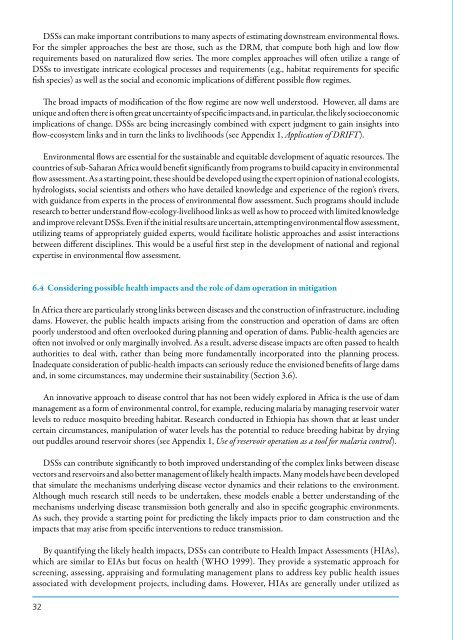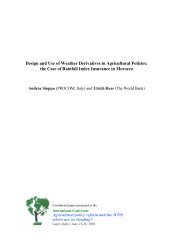Use of decision support systems to improve dam planning and dam ...
Use of decision support systems to improve dam planning and dam ...
Use of decision support systems to improve dam planning and dam ...
Create successful ePaper yourself
Turn your PDF publications into a flip-book with our unique Google optimized e-Paper software.
DSSs can make important contributions <strong>to</strong> many aspects <strong>of</strong> estimating downstream environmental flows.<br />
For the simpler approaches the best are those, such as the DRM, that compute both high <strong>and</strong> low flow<br />
requirements based on naturalized flow series. The more complex approaches will <strong>of</strong>ten utilize a range <strong>of</strong><br />
DSSs <strong>to</strong> investigate intricate ecological processes <strong>and</strong> requirements (e.g., habitat requirements for specific<br />
fish species) as well as the social <strong>and</strong> economic implications <strong>of</strong> different possible flow regimes.<br />
The broad impacts <strong>of</strong> modification <strong>of</strong> the flow regime are now well unders<strong>to</strong>od. However, all <strong>dam</strong>s are<br />
unique <strong>and</strong> <strong>of</strong>ten there is <strong>of</strong>ten great uncertainty <strong>of</strong> specific impacts <strong>and</strong>, in particular, the likely socioeconomic<br />
implications <strong>of</strong> change. DSSs are being increasingly combined with expert judgment <strong>to</strong> gain insights in<strong>to</strong><br />
flow-ecosystem links <strong>and</strong> in turn the links <strong>to</strong> livelihoods (see Appendix 1, Application <strong>of</strong> DRIFT).<br />
Environmental flows are essential for the sustainable <strong>and</strong> equitable development <strong>of</strong> aquatic resources. The<br />
countries <strong>of</strong> sub-Saharan Africa would benefit significantly from programs <strong>to</strong> build capacity in environmental<br />
flow assessment. As a starting point, these should be developed using the expert opinion <strong>of</strong> national ecologists,<br />
hydrologists, social scientists <strong>and</strong> others who have detailed knowledge <strong>and</strong> experience <strong>of</strong> the region’s rivers,<br />
with guidance from experts in the process <strong>of</strong> environmental flow assessment. Such programs should include<br />
research <strong>to</strong> better underst<strong>and</strong> flow-ecology-livelihood links as well as how <strong>to</strong> proceed with limited knowledge<br />
<strong>and</strong> <strong>improve</strong> relevant DSSs. Even if the initial results are uncertain, attempting environmental flow assessment,<br />
utilizing teams <strong>of</strong> appropriately guided experts, would facilitate holistic approaches <strong>and</strong> assist interactions<br />
between different disciplines. This would be a useful first step in the development <strong>of</strong> national <strong>and</strong> regional<br />
expertise in environmental flow assessment.<br />
6.4 Considering possible health impacts <strong>and</strong> the role <strong>of</strong> <strong>dam</strong> operation in mitigation<br />
In Africa there are particularly strong links between diseases <strong>and</strong> the construction <strong>of</strong> infrastructure, including<br />
<strong>dam</strong>s. However, the public health impacts arising from the construction <strong>and</strong> operation <strong>of</strong> <strong>dam</strong>s are <strong>of</strong>ten<br />
poorly unders<strong>to</strong>od <strong>and</strong> <strong>of</strong>ten overlooked during <strong>planning</strong> <strong>and</strong> operation <strong>of</strong> <strong>dam</strong>s. Public-health agencies are<br />
<strong>of</strong>ten not involved or only marginally involved. As a result, adverse disease impacts are <strong>of</strong>ten passed <strong>to</strong> health<br />
authorities <strong>to</strong> deal with, rather than being more fun<strong>dam</strong>entally incorporated in<strong>to</strong> the <strong>planning</strong> process.<br />
Inadequate consideration <strong>of</strong> public-health impacts can seriously reduce the envisioned benefits <strong>of</strong> large <strong>dam</strong>s<br />
<strong>and</strong>, in some circumstances, may undermine their sustainability (Section 3.6).<br />
An innovative approach <strong>to</strong> disease control that has not been widely explored in Africa is the use <strong>of</strong> <strong>dam</strong><br />
management as a form <strong>of</strong> environmental control, for example, reducing malaria by managing reservoir water<br />
levels <strong>to</strong> reduce mosqui<strong>to</strong> breeding habitat. Research conducted in Ethiopia has shown that at least under<br />
certain circumstances, manipulation <strong>of</strong> water levels has the potential <strong>to</strong> reduce breeding habitat by drying<br />
out puddles around reservoir shores (see Appendix 1, <strong>Use</strong> <strong>of</strong> reservoir operation as a <strong>to</strong>ol for malaria control).<br />
DSSs can contribute significantly <strong>to</strong> both <strong>improve</strong>d underst<strong>and</strong>ing <strong>of</strong> the complex links between disease<br />
vec<strong>to</strong>rs <strong>and</strong> reservoirs <strong>and</strong> also better management <strong>of</strong> likely health impacts. Many models have been developed<br />
that simulate the mechanisms underlying disease vec<strong>to</strong>r dynamics <strong>and</strong> their relations <strong>to</strong> the environment.<br />
Although much research still needs <strong>to</strong> be undertaken, these models enable a better underst<strong>and</strong>ing <strong>of</strong> the<br />
mechanisms underlying disease transmission both generally <strong>and</strong> also in specific geographic environments.<br />
As such, they provide a starting point for predicting the likely impacts prior <strong>to</strong> <strong>dam</strong> construction <strong>and</strong> the<br />
impacts that may arise from specific interventions <strong>to</strong> reduce transmission.<br />
By quantifying the likely health impacts, DSSs can contribute <strong>to</strong> Health Impact Assessments (HIAs),<br />
which are similar <strong>to</strong> EIAs but focus on health (WHO 1999). They provide a systematic approach for<br />
screening, assessing, appraising <strong>and</strong> formulating management plans <strong>to</strong> address key public health issues<br />
associated with development projects, including <strong>dam</strong>s. However, HIAs are generally under utilized as<br />
32





